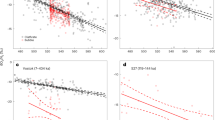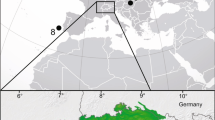Abstract
Air entrapped in bubbles formed in cold ice has essentially the same composition as that of the atmosphere at the time of bubble formation. The analysis of dated ice samples therefore enables the history of atmospheric composition to be investigated.1–3 The age of the entrapped air is, however, not the same as that of the surrounding ice because air bubbles only become isolated from the atmosphere during the transition from firn to ice. Typically the age of the ice at this transition is between 100 and 3,000 yr, depending mainly on firn temperature and snow accumulation rate. The mean age difference between ice and enclosed air, as well as the age distribution width for a given sample, are especially important for the investigation of the anthropogenic increase of CO2 and trace gases in the atmosphere over the last centuries, and for the comparison of climatic parameters recorded in the ice with parameters recorded in the bubbles. For Siple Station (Antarctica), this age difference and age distribution width were deduced from the bubble volume measured as a function of depth. The values are 95 yr and 22 yr respectively.
This is a preview of subscription content, access via your institution
Access options
Subscribe to this journal
Receive 51 print issues and online access
$199.00 per year
only $3.90 per issue
Buy this article
- Purchase on Springer Link
- Instant access to full article PDF
Prices may be subject to local taxes which are calculated during checkout
Similar content being viewed by others
References
Delmas, R. J., Ascencio, J.-M. & Legrand, M. Nature 284, 155–157 (1980).
Neftel, A., Oeschger, H., Schwander, J., Stauffer, B. & Zumbrunn, R. Nature 295, 220–223 (1982).
Stauffer, B., Hofer, H., Oeschger, H., Schwander, J. & Siegenthaler, U. Ann. Glaciol. (in the press).
Langway, C. C. Jr Physics of the Movement of the Ice, Chamonix (IUGG Meet., IAHS Publ. No. 47, 336–349, 1958).
Raynaud, D. & Lebel, B. Nature 281, 289–291 (1979).
Neftel, A., Oeschger, H., Schwander, J. & Stauffer, B. J. phys. Chem. 87, 4116–4120 (1983).
Hammer, C. U. J. Glaciol. 25, 359–372 (1980).
Stauffer, B. & Schwander, J. Antarct. J. 18, No. 5 (1983).
Loosli, H. H. Earth planet. Sci. Lett. 63, 51–62 (1983).
Stauffer, B. Z. Gletscherk. Glazialgeol. 17, 17–56 (1981).
Herron, M. M. & Langway, C. C. J. Glaciol. 25, 373–385 (1980).
Author information
Authors and Affiliations
Rights and permissions
About this article
Cite this article
Schwander, J., Stauffer, B. Age difference between polar ice and the air trapped in its bubbles. Nature 311, 45–47 (1984). https://doi.org/10.1038/311045a0
Received:
Accepted:
Issue Date:
DOI: https://doi.org/10.1038/311045a0
This article is cited by
-
Firn on ice sheets
Nature Reviews Earth & Environment (2024)
-
Atmospheric methane variability through the Last Glacial Maximum and deglaciation mainly controlled by tropical sources
Nature Geoscience (2023)
-
Precise interpolar phasing of abrupt climate change during the last ice age
Nature (2015)
-
Centennial-scale changes in the global carbon cycle during the last deglaciation
Nature (2014)
-
Reconstruction of Antarctic climate change using ice core proxy records from the coastal Dronning Maud Land, East Antarctica
Journal of the Geological Society of India (2011)
Comments
By submitting a comment you agree to abide by our Terms and Community Guidelines. If you find something abusive or that does not comply with our terms or guidelines please flag it as inappropriate.



